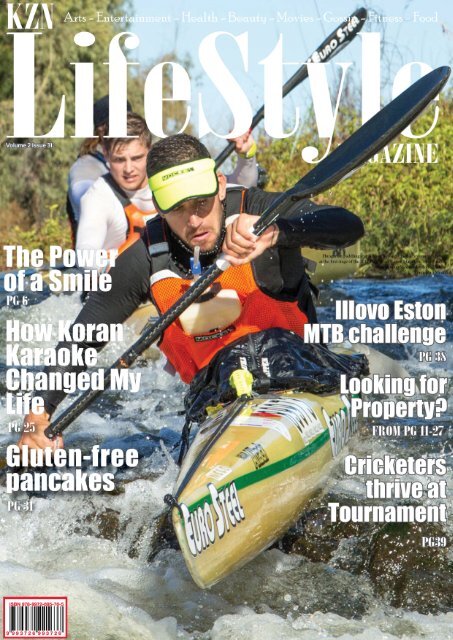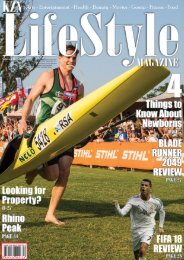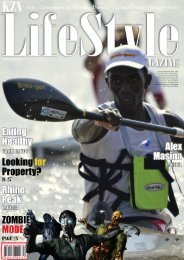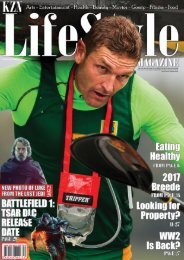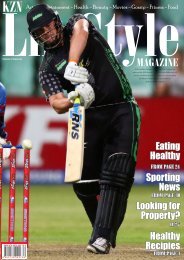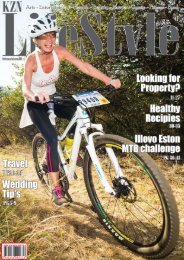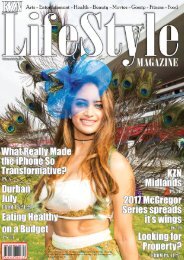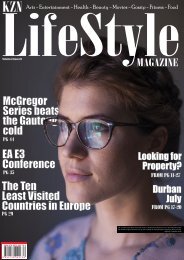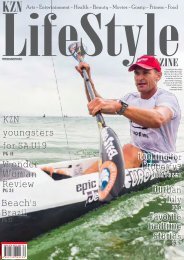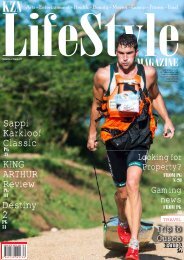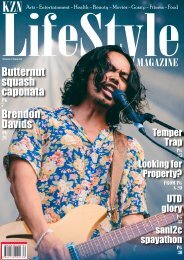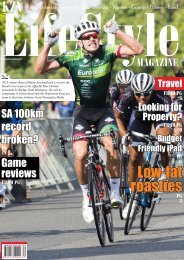KZN#31.indd
You also want an ePaper? Increase the reach of your titles
YUMPU automatically turns print PDFs into web optimized ePapers that Google loves.
Goals<br />
Join the Celebratation - 100 Years of Making Life Delicious<br />
Since our establishment in Estcourt in 1917, Eskort has become a household name associated with<br />
delicious pork and Eskort branded products from the famous Gold Medal Pork Sausages,<br />
Wiltshire Cured Bacon and now delicious new Gourmet American Hot Dogs.<br />
American Hot Dogs<br />
Smoked Gourmet Regular 380 g or Smoked Gourmet Chilli Cheese 380 g<br />
Now available at Eskort Butcheries and soon at a store near you.<br />
Visit eskort.com - Your 1-Stop Inspiration Station, Facebook.com/EskortLifesDelicious or Instagram.com/EskortFood
Babies<br />
The Power of a Smile<br />
by Sue Gerhardt<br />
As the world comes<br />
into focus, vision<br />
plays an increasingly<br />
important part in relationships.<br />
Eye contact now becomes the<br />
main source of information<br />
about other people's feelings<br />
and intentions: feelings are seen<br />
on the face. This reliance on<br />
faces may have evolved on the<br />
African savannah where it was<br />
necessary for our primate ancestors<br />
to communicate silently so<br />
as not to alert predators. This<br />
was done through visual means,<br />
developing a wide repertoire<br />
of facial movements and body<br />
language to convey information<br />
(Turner 2000). Certainly<br />
attentiveness to faces is hardwired<br />
into human beings and is<br />
evident even in newborns.<br />
By toddlerhood, the human<br />
child has started to use his mother's<br />
and father's faces as his<br />
immediate guides to behaviour<br />
in his particular environment. Is<br />
it safe to crawl out of this door?<br />
Does Dad like this visitor? This<br />
is known as 'social referencing',<br />
with the infant using visual<br />
communication at a distance to<br />
check out what to do and what<br />
not to do, what to feel and what<br />
not to feel, using the parent's<br />
facial expression as his source<br />
of information (Feinman 1992).<br />
But according to Allan tal region of the brain. 'Endogenous'<br />
or home-made opioids like<br />
Schore, looking at faces has<br />
an even more powerful role to beta-endorphin are known to<br />
play in human life. Especially in help neurons to grow, by regulating<br />
glucose and insulin (Schore<br />
infancy, these looks and smiles<br />
actually help the brain to grow. 1994). As natural opioids, they<br />
How does this work? Schore also make you feel good. At<br />
suggests that it is positive looks the same time, another neurotransmitter<br />
called dopamine is<br />
which are the most vital stimulus<br />
to the growth of the social, released from the brainstem, and<br />
emotionally intelligent, brain again makes its way to the prefrontal<br />
cortex. This too enhances<br />
When the baby looks at his<br />
mother (or father), he reads the uptake of glucose there,<br />
her dilated pupils as information<br />
that her sympathetic nerv-<br />
the prefrontal brain. Dopamine<br />
helping new tissue to grow in<br />
ous system is aroused, and she probably also feels good, insofar<br />
is experiencing pleasurable as it produces an energising and<br />
arousal. In response, his own stimulating effect; it is involved<br />
nervous system becomes pleasurably<br />
aroused and his own by this technical and circuitous<br />
in the anticipation of reward. So<br />
heart rate goes up. These processes<br />
trigger off a biochemical ily's doting looks are triggering<br />
route, we discover that the fam-<br />
response. First, a pleasure neuropeptide<br />
called beta-endorphin is cals that actually help the social<br />
off the pleasurable biochemi-<br />
released into the circulation and brain to grow (Schore 1994).<br />
specifically into the orbitofron-<br />
The baby's brain is doing a<br />
6 Kzn Lifestyle Magazine • Issue 31<br />
Read full story here<br />
lot of growing in the first year -<br />
it more than doubles in weight.<br />
The enormously increased glucose<br />
metabolism of the first two<br />
years of life, triggered by the<br />
baby's biochemical responses<br />
to his mother, facilitates the<br />
expression of genes. Like so<br />
much else about human development,<br />
genetic expression frequently<br />
depends on social input<br />
to become manifest. The hippocampus,<br />
temporal cortex, prefrontal<br />
and anterior cingulate<br />
are all immature at birth. But<br />
the success of their growth and<br />
genetic development depends on<br />
the amount of good experiences<br />
the individual has. Lots of positive<br />
experiences early on produce<br />
brains with more neuronal<br />
connections -more richly networked<br />
brains. We have all our<br />
neurons at birth, and we don't<br />
need to grow any more, but what<br />
we do need is to connect them<br />
up and make them work for us.<br />
With more connections, there<br />
is better performance and more<br />
ability to use particular areas of<br />
the brain.<br />
In particular, between 6 and<br />
12 months, there is a massive<br />
burst of these synaptic connections<br />
in the prefrontal cortex.<br />
They achieve their highest density<br />
just when the developing<br />
pleasurable relationship between<br />
parents and baby is most intense,<br />
and attachment bonds are being<br />
consolidated. This growth spurt<br />
in the prefrontal cortex reaches<br />
a final high pitch in early toddlerhood,<br />
when the novelty of<br />
being able to move independently<br />
creates elation in the toddler<br />
and pride and joy in his parents.<br />
In effect, the baby has now<br />
become a social being, with the<br />
beginnings of a social brain. But<br />
it takes most of the first year to<br />
reach this point.
Babies<br />
Baby smarts: 5 fascinating<br />
things babies know<br />
Your baby is so much more than just a pretty face. A growing body of research shows that babies understand far more about their environment than we<br />
realized before. (DREAMSTIME PHOTO)<br />
For a long time, we<br />
didn’t give young<br />
babies the credit they<br />
deserved for being eager young<br />
scientists. We treated them as if<br />
they were in some developmental<br />
stage of limbo, waiting to<br />
awake from a Sleeping Beautylike<br />
state of not-quite-being.<br />
Now we know that we were<br />
totally underestimating the abilities<br />
of babies. A growing body<br />
of research indicates that babies<br />
are much more tuned into their<br />
environment than we realized.<br />
Here’s what we’ve learned from<br />
five recent studies about babies.<br />
Babies are tuned into Channel<br />
Mom. Researchers from the<br />
University of Montreal and the<br />
Sainte-Justine University Hospital<br />
Research Centre have discovered<br />
that the part of a baby’s<br />
brain that is responsible for language<br />
is activated in unique and<br />
powerful ways when a baby<br />
hears the sound of his mother’s<br />
voice. To make this discovery,<br />
the researchers applied<br />
electrodes to the heads of 16<br />
newborn babies while they were<br />
sleeping and tracked the babies’<br />
reactions while their mothers<br />
and female nurses took turns<br />
making vowel sounds. The brain<br />
scans indicated that the infants<br />
— who were less than 24 hours<br />
old at the time — could already<br />
recognize their mothers’ voices.<br />
Babies can speak dog. Or, to<br />
be more precise, they can interpret<br />
the meaning of dog barks<br />
— even if they have never been<br />
around dogs. Researchers from<br />
Brigham Young University<br />
found that babies as young as six<br />
months of age are able to match<br />
the sounds of an angry snarl and<br />
a friendly yap with photos of<br />
dogs that appear either threatening<br />
or friendly. In other words,<br />
they can interpret the emotions<br />
associated with sounds.<br />
Babies understand the law<br />
of the jungle. Psychologists at<br />
Harvard University designed<br />
an experiment for babies in<br />
which two blocks of different<br />
size came into conflict. (These<br />
blocks had human facial features<br />
and wanted to pass by one<br />
another.) Babies aged eight to<br />
ten months expressed surprise<br />
if the bigger block stepped aside<br />
to let the smaller block pass by.<br />
They expected the bigger block<br />
to get its way because of its size.<br />
Babies have a strong sense of<br />
justice. A study led by Professor<br />
Kiley Hamlin of The University<br />
of British Columbia department<br />
of psychology found that<br />
babies don’t mind seeing people<br />
punished if those people have<br />
acted poorly; and that they don’t<br />
like to see people who have<br />
behaved badly being rewarded.<br />
The researchers used a series of<br />
puppets and monitored the reactions<br />
of 100 babies to reach this<br />
conclusion. They found that the<br />
desire to see justice served kicks<br />
in when babies are about eight<br />
months of age.<br />
Babies can tell jokes. Babies<br />
know how to tell jokes even<br />
before they can talk. A baby’s<br />
idea of a joke? To pretend to<br />
hand a toy to another child, only<br />
to snatch that toy away from the<br />
other child at the last minute.<br />
(For maximum hilarity, do this<br />
repeatedly.) Researchers at Australia’s<br />
Charles Sturt University<br />
were able to pick up on this<br />
behaviour (which occurs by age<br />
12 months) by studying footage<br />
shot from tiny cameras (“babycams”)<br />
mounted to hats or headbands<br />
worn by babies in childcare.<br />
So there you have it — the<br />
latest evidence that your baby<br />
is, if not a genius, at least very<br />
smart. The grandparents will<br />
definitely be impressed.<br />
Ann Douglas is the author of<br />
The Mother of All Pregnancy<br />
Books (Wiley, 2011) and numerous<br />
other books about pregnancy<br />
and parenting. Her website is<br />
www.having-a-baby.com and<br />
she is @anndouglas on Twitter.<br />
Kzn Lifestyle Magazine • Issue 31<br />
7
The real truth<br />
about girls<br />
and boys<br />
Any study I’ve come are still babes in arms.<br />
across that attempts It’s not usual, for example,<br />
for parents to have differ-<br />
to make the sugarand-spice<br />
case for girls and ent ideas about how much risk<br />
the puppy-dog-tails case for baby girls can tolerate as compared<br />
to baby boys. In one study<br />
boys fails what I like to call<br />
“the Julie test.” It doesn’t stand of 11-month-old babies, Barnett<br />
notes, mothers were asked<br />
up to what I’ve learned from<br />
parenting my daughter Julie<br />
to adjust the angle of a carpeted<br />
ramp to show the angle<br />
(the poster child for non-girlygirls)<br />
and her three brothers<br />
(who are anything but three<br />
they thought their babies would<br />
peas in a pod).<br />
be capable of crawling down.<br />
Any noteworthy differences The mothers underestimated<br />
in behaviour between boys their daughters’ abilities even<br />
and girls that become obvious<br />
as children grow older are be more daring than the baby<br />
though the baby girls proved to<br />
the result of nurture rather than boys. “They provided the baby<br />
nature, says Rosalind C. Barnett,<br />
co-author (with Caryl Riv-<br />
environment in an attempt to<br />
girls with a less challenging<br />
ers) of The Truth About Girls protect them from injury.”<br />
and Boys: Challenging Toxic Boys can also miss out on<br />
Stereotypes About Our Children<br />
(Columbia University ents unconsciously buy into ste-<br />
opportunities for growth if par-<br />
Press: New York, 2011). reotypical ideas about what it<br />
“People assume these gender<br />
differences are innate, but 2006 study, mothers of prever-<br />
means to grow up male. “In a<br />
research shows they are learned bal infants who were 6, 9 and<br />
differences – the result of girls 14 months old were observed<br />
and boys being socialized in in a free-play situation with<br />
different ways,” says Barnett in gender-neutral toys,” Barnett<br />
an interview with the Star. and Rivers note in The Truth<br />
In their book, she and Rivers About Girls and Boys. The<br />
explain that “Because the brain behaviour of the boys and girls<br />
is ever-changing in response to was identical, but the mother’s<br />
way of interacting with her<br />
all sorts of learning, the brain of<br />
any one boy may differ considerably<br />
from that of another boy. sex. “With little girls, moth-<br />
baby depended on the child’s<br />
And, of course, the same is true ers engaged in more conversation<br />
and expected their daugh-<br />
for girls.”<br />
As parents, we have the ters to be more responsive than<br />
opportunity to help our children their sons.”<br />
to push past the limits that gender<br />
stereotypes would other-<br />
in the same type of language-<br />
To ensure that boys grow up<br />
wise set for them, says Barnett. rich environment as girls, Barnett<br />
and Rivers advise parents<br />
To do that, we need to become<br />
aware of the stereotypes that to ensure that the language that<br />
may already be influencing they use when communicating<br />
our parenting (and limiting our with their sons is “rich and peppered<br />
with emotion.”<br />
kids), even while our children<br />
Kzn Lifestyle Magazine • Issue 31 8 Kzn Lifestyle Magazine • Issue 31
Babies<br />
Mama’s Milk Project a website<br />
celebrates breastfeeding: The<br />
Mother of All Parenting Columns<br />
Read full story here<br />
A<br />
shared passion for<br />
documentary storytelling<br />
and activism<br />
gave birth to a friendship that<br />
sustained two women through<br />
early motherhood. And that<br />
friendship inspired Kathryn<br />
Palmateer and Martha Solomon<br />
to create the Mama’s Milk<br />
Project www.mamasmilkproject.<br />
com, a website that both documents<br />
and celebrates breastfeeding.<br />
The website, which launched<br />
May 1, seeks “to foster a positive,<br />
creative, and supportive<br />
breastfeeding community for<br />
moms and their families, to normalize<br />
the practice of breastfeeding,<br />
. . . to examine the<br />
issues that women face when<br />
breastfeeding, to pass along<br />
women’s hard-earned breastfeeding<br />
wisdom and experience.<br />
. . . [and to] allow women<br />
a space to reflect upon and write<br />
about their breastfeeding experiences<br />
as an important life experience.”<br />
Creating an online space<br />
that is positive and beautiful —<br />
each story is complemented by<br />
a beautiful portrait of a mother<br />
breastfeeding — was a deliberate<br />
decision. Palmateer and Solomon,<br />
who both live in Toronto,<br />
are seeking to shift the debate.<br />
“Breastfeeding doesn’t have<br />
to be that kind of hard debate we<br />
see in the mainstream media —<br />
that either you’re pro breastfeeding<br />
or you’re anti-breastfeeding;<br />
can we do it in public; can we<br />
not do it in public?” says Palmateer.<br />
“Let’s talk about what it<br />
means for women and what it<br />
means for children.”<br />
“I think one of our big things<br />
is trying to normalize the discussion<br />
about breastfeeding.<br />
Instead of making it an inflammatory,<br />
controversial adversarial<br />
thing, we just want to present<br />
breastfeeding as ‘This is what<br />
women are doing right now and<br />
this is what children are doing<br />
right now,’ and talking about it<br />
in a way that recognizes that it’s<br />
as a wonderful, special, often<br />
kind-of-difficult thing, but it’s<br />
also an everyday thing.”<br />
Palmateer and Solomon also<br />
want to focus on kids’ experiences<br />
with breastfeeding: “how<br />
children feel about breastfeeding<br />
and how they communicate<br />
about breastfeeding with their<br />
families.”<br />
A mother named Kim shares<br />
her family’s experiences in an<br />
article entitled “The real Breastfeeding<br />
Experts.”<br />
“My first daughter very<br />
clearly said, ‘nurse’ starting<br />
at about 10 months. She also<br />
signed the sign for milk to say<br />
she wanted to nurse.<br />
I vividly remember her holding<br />
my face in her hands when<br />
she was about 22 months and<br />
saying, ‘Mama, listen with ears:<br />
I want to nurse.”<br />
Palmateer and Solomon aren’t<br />
shy about the fact that they are<br />
reproductive justice activists and<br />
that they want to ignite a discussion<br />
about the broader social<br />
issues that determine a mother’s<br />
true breastfeeding options.<br />
Kzn Lifestyle Magazine • Issue 31<br />
9
Advertising with us will get your company<br />
name out there with one click of the button,<br />
shared across the web in a instant!!! Forget<br />
about bad print errors or late distributions! it’s<br />
all at your fingertips a click away
R6,999,999<br />
ntury 21 SHOW HOUSE NEAR YOU<br />
Tel. 071 886 8969 |<br />
Email: ruan.erasmus@century21.co.za
e
R11,999,000<br />
ntury 21 SHOW HOUSE NEAR YOU<br />
Tel. 071 886 8969 |<br />
Email: ruan.erasmus@century21.co.za
Travel<br />
How Korean Karaoke Changed<br />
My Life<br />
Growing up, I was The<br />
One Who Could Not<br />
Sing. My older sister<br />
and brother, on the other hand,<br />
were routinely cast in musicals<br />
and chosen for high school<br />
Madrigals (the “Glee”-like<br />
choir reserved for the cream of<br />
the teen vocal crop). At Christmas,<br />
my siblings harmonized<br />
over “We Three Kings”—and<br />
while they charitably let me<br />
sing along, it was pretty clear<br />
who was the weakest king.<br />
Meanwhile, my father<br />
enforced strict family rules blatantly<br />
designed to silence my<br />
ambitious lungs:<br />
1. No singing in the morning<br />
before breakfast.<br />
2. No singing at the table<br />
(breakfast, lunch, or dinner).<br />
None of this deterred me. I<br />
sang in the afternoon and evening,<br />
in the shower and in my<br />
bedroom and standing on livingroom<br />
furniture. I sang in the car<br />
and in the grocery store, my fist<br />
serving as a microphone. And as<br />
I entered my teens in the ‘80s, I<br />
sang everything on offer: Bananarama<br />
and Boy George, Rick<br />
Springfield and Richard Marx,<br />
Oingo Boingo and OMD, Tanya<br />
Tucker and Tammy Wynette,<br />
Guns N’ Roses and Quiet Riot.<br />
I sang it all, I sang it loud, and I<br />
sang it off-key.<br />
“You can’t carry a tune in a<br />
bucket,” my father told me.<br />
“You couldn’t sing your way<br />
out of a paper bag,” he also said.<br />
I rolled my eyes at him and<br />
sang even louder.<br />
When I entered high school,<br />
I couldn’t wait to audition for<br />
choir. On the second day of<br />
classes, I charged into the music<br />
room filled with optimism, and<br />
found Mrs. Best, the music<br />
instructor, looking equally hopeful<br />
(she had, after all, been<br />
blessed with my siblings for<br />
pupils). Mrs. Best instructed me<br />
to stand beside the piano, then<br />
she played a note I was to replicate<br />
in song. I tried. Her eyebrows<br />
furrowed. She played a<br />
different key. I tried again. Her<br />
brows furrowed further. After<br />
about three minutes of this—<br />
her brows now puckered somewhere<br />
around her chin—I was<br />
sent away and not invited back.<br />
I was crushed. After that, I continued<br />
to sing in private, but in<br />
public, I kept my vocal stylings<br />
to myself.<br />
Things changed when I<br />
moved to South Korea straight<br />
out of college to teach English as<br />
a Second Language. A few days<br />
after I had arrived, my school<br />
principal suggested that all the<br />
American and Korean teachers<br />
dine together then hit a noraebang,<br />
or “song room.” In other<br />
words, Korean-style karaoke.<br />
The Americans were reluctant,<br />
but attendance was not optional.<br />
Cropped photo by Lisa Risager,<br />
Flickr, (Creative Commons)<br />
After dinner, which included<br />
endless bottles of beer and soju,<br />
our group of 10 crossed the street<br />
to a noraebang and crowded into<br />
a small, dark, private room lined<br />
with vinyl strawberry-colored<br />
padded benches, atrocious flowered<br />
wallpaper, and one low<br />
table. A disco ball hung from the<br />
ceiling, and a television monitor<br />
on the wall played a video<br />
of David Lee Roth and Eddie<br />
Van Halen jumping and gyrating.<br />
(The same video repeated<br />
all night, accompanying every<br />
song, but at no point was a Van<br />
Halen tune actually played.)<br />
As soon as we squeezed<br />
around the table, the Koreans<br />
handed us thick binders that catalogued<br />
thousands of Korean<br />
songs, plus three thin pages<br />
of English tunes. Most of the<br />
names of singers and songs were<br />
misspelled, while others were<br />
merely incomplete, like the classic<br />
Elvis number, “You Ain’t<br />
Nothin’ But a Ho.”<br />
Then one of the Korean teachers<br />
cued up a disco remix of Stevie<br />
Wonder’s “I Just Called to<br />
Read full story here<br />
Say I Love You,” and—following<br />
her lead—we danced, shook<br />
plastic tambourines, drank beer,<br />
ate shrimp-flavored chips, and<br />
sang along. It wasn’t so bad: A<br />
private room was a considerable<br />
improvement over the ignominy<br />
of public karaoke bars<br />
back home.<br />
But there were two things<br />
about noraebang we didn’t yet<br />
know. First, not only was participation<br />
obligatory—there was<br />
no “sitting this one out”—but<br />
everyone was also expected to<br />
take a solo. So while the American<br />
contingent was initially<br />
allowed to sing group tunes (we<br />
chose “Sweet Caroline” and<br />
“California Dreaming”), before<br />
long the microphone was being<br />
passed from person to person.<br />
Lionel Richie, Celine Dion, and<br />
Julio Iglesias were being soloed,<br />
with nary a hint of irony, along<br />
with popular Korean boy bands<br />
G.O.D. (Groove Overdose) and<br />
H.O.T (High-five of Teenagers).<br />
Kzn Lifestyle Magazine • Issue 31<br />
25
Travel<br />
War Story<br />
I‘d always assumed my<br />
father had killed people.<br />
He’d never talked about<br />
it. To be fair, I’d never asked<br />
him. I’d never had the nerve.<br />
But today was different. We<br />
were away from home, and<br />
through the paradigm-shifting<br />
power of travel, I felt emboldened.<br />
I was driving our rented<br />
Opel station wagon through the<br />
Belgian countryside, past fields<br />
dotted with wildflowers and fat<br />
cows. I was thirty. He was seventy-six,<br />
a gentle man with<br />
short, gray hair and big glasses.<br />
I kept my eyes on the road<br />
and took a deep breath.<br />
“Dad, in all of the time<br />
you’ve talked about the war,<br />
you’ve never talked about having<br />
to shoot people.”<br />
It wasn’t exactly a question—<br />
26<br />
The author’s father, circa 1944.<br />
Kzn Lifestyle Magazine • Issue 31<br />
more of an observation. It was<br />
the best I could do.<br />
My dad grew quiet and<br />
looked out the window.<br />
“Who wants to talk about<br />
something like that?” he said.<br />
He had a point. The afternoon<br />
sunlight reflected off the Opel’s<br />
silver hood. I wondered whether<br />
to press on or drop the subject<br />
forever.<br />
Father-son relationships<br />
are rarely easy, but my dad is<br />
one of the “Greatest Generation”—men<br />
who grew up during<br />
the Depression, fought in<br />
World War II and, upon returning<br />
home, were often frustratingly<br />
quiet and inscrutable. My<br />
dad was 46 when I was born.<br />
The older I got, the more aware I<br />
became of the gulf between us—<br />
not just the decades or our differing<br />
diction (my dad was old<br />
enough to call companies “outfits”),<br />
but in the way we talked<br />
about our lives. He was a good<br />
man—always supportive—but<br />
he could be remote, and even, I<br />
thought at times, unknowable.<br />
I longed to bridge the divide,<br />
and I was just young enough to<br />
think I could. Like many sons of<br />
veterans, I thought my father’s<br />
years at war might hold a key to<br />
understanding him—that somewhere<br />
in the bloom of youth and<br />
the trauma of combat, the kernel<br />
of the man I knew was formed.<br />
What’s more, I believed in the<br />
power of travel to work magic:<br />
Blend enough time and movement<br />
in a foreign place and a kind<br />
of alchemy can occur. Things<br />
can happen—good things—that<br />
might not occur back home. So I<br />
asked my dad to travel with me<br />
to Western Europe, to show me<br />
some of the places where he’d<br />
fought. If I were lucky, I’d return<br />
home feeling closer to him, and<br />
maybe, by extension, a little<br />
more at peace with myself, too.<br />
We landed in Paris on a cool<br />
spring afternoon and wasted no<br />
time in hitting the road, exploring<br />
small towns where he’d<br />
been. One afternoon, we headed<br />
for Bastogne in Belgium. In<br />
December of 1944, the German<br />
army attacked Allied troops<br />
here, igniting the Battle of the<br />
Bulge. At the time, my father<br />
was a paratrooper with the 82nd<br />
Airborne Division. He was soon<br />
embroiled in combat and would<br />
be for days.<br />
We wandered into a museum<br />
and watched a short documentary<br />
about the battle. Black-andwhite<br />
footage showed American<br />
soldiers marching through<br />
snow. Explosions flashed on<br />
the screen, along with photos<br />
of corpses. My father was sitting<br />
beside me, and I heard his<br />
breathing change. He wiped his<br />
eyes.<br />
Afterward, we drove past<br />
towering evergreens. He was<br />
quiet.<br />
“How did you feel watching<br />
the movie, dad?”<br />
“Emotional.”<br />
“Sad?”<br />
My father was capable of<br />
wide-ranging political conversations.<br />
I hated asking a question<br />
that sounded better suited for a<br />
child, but in this case, I thought<br />
conversational baby steps might<br />
be the best approach.<br />
“Yeah.”<br />
“How so?”<br />
“Just seeing all that. It was<br />
such an awful war.”<br />
As we drove on, I thought<br />
about my dad’s teen years. He’d<br />
grown up in St. Louis. When<br />
the U.S. entered the war, he and<br />
three of his brothers enlisted. My<br />
father was just 17 at the time—<br />
still a kid, really. He took part in<br />
some of the war’s worst fighting,<br />
including the Battle of the<br />
Hurtgen Forest, in which tens<br />
of thousands of Americans were<br />
killed. I wondered how much of<br />
my dad’s reticence was innate,<br />
and how much was shaped by<br />
those battles. I thought about<br />
how we still don’t have a good<br />
way to measure the toll war takes<br />
on survivors, and the way war’s<br />
effects could be passed along in<br />
one form or another from fathers<br />
to sons, and mothers to daughters—a<br />
kind of lingering posttraumatic<br />
stress that trickles<br />
down, however subtly, through<br />
generations. I thought about the<br />
grief my father seemed to carry<br />
at times, and wondered if it was<br />
the same grief I sometimes felt,<br />
seemingly inexplicably.<br />
I didn’t mention any of this.<br />
In fact, I was so quiet my dad<br />
grew concerned.<br />
“How are you doing?” he<br />
said.<br />
Maybe this was an opening.<br />
“Okay, I guess. You don’t<br />
always have much to say. It can<br />
be hard sometimes.”<br />
“You think that’s unusual?”<br />
“Just a generational difference<br />
between us, I think.”<br />
He grew quiet. We passed a<br />
creek.<br />
“Pretty river,” he said.
Travel<br />
The Accidental Hitchhiker<br />
“Are you going far?” the<br />
Samoan man asked as he<br />
leaned into my creaky<br />
rental car. We were under the<br />
shade of an avocado tree. His<br />
bulk filled the entire space of<br />
my open window.<br />
When he’d flagged me down,<br />
I’d thought he was an elder collecting<br />
a “customs fee,” the<br />
few dollars it costs to use village<br />
roads that lead to many of<br />
Samoa’s sights. He’d been sitting<br />
idly in a greying roadside<br />
shack built for such occasions,<br />
but he wasn’t asking for money;<br />
he was trying to hitch a ride.<br />
I didn’t want to pick him up,<br />
but I’d already stopped and I<br />
needed directions.<br />
“I’m trying to get to Pulemelei<br />
Mound,” I said, trying not to<br />
sound as lost as I was. “Do you<br />
know how to get there?”<br />
“Mmm,” he said, raising his<br />
eyebrows in the classic Polynesian<br />
gesture for yes. “I need to<br />
pick up my car at the mechanic<br />
but no hurry, I’ll take you there<br />
first if you want.”<br />
Normally I wouldn’t pick<br />
up a hitchhiker, especially not<br />
such a huge one, but this man<br />
had such a gentle expression<br />
that I sensed he was OK. Having<br />
spent 15 years in and around<br />
Tahiti, which has a similar culture,<br />
I knew Polynesians pretty<br />
well - many hulks had the temperament<br />
of bunny rabbits.<br />
Plus, if he knew where Pulemelei<br />
Mound was, I’d just gotten<br />
closer to living out a dream.<br />
I’d wanted to go to Pulemelei<br />
since I’d heard it mentioned in<br />
an archaeology class years ago.<br />
The “mound” is actually a pyramid<br />
40 feet high and roughly 200<br />
feet across at its base—a little<br />
over one-third the height of the<br />
Kukulkan pyramid in Chichen<br />
Itza, Mexico, and slightly wider.<br />
Like many of the world’s pyramids,<br />
Pulemelei is oriented to<br />
the cardinal directions. It was<br />
built some time around 1300<br />
AD and no one knows what it<br />
was used for. But one thing is<br />
certain: It’s the largest ancient<br />
structure in Polynesia.<br />
You’d think that a giant pyramid<br />
would be a major sight, or<br />
28<br />
Kzn Lifestyle Magazine • Issue 31<br />
at least something many people<br />
had heard of, but it isn’t. My<br />
accidental hitchhiker’s affirmative<br />
raise of the eyebrows was<br />
the most promising prospect I’d<br />
had in a week.<br />
“Hop in,” I told him.<br />
We rattled along the road in<br />
silence for a few minutes. A half<br />
dozen chickens squawked and<br />
ran into a hibiscus hedge next<br />
to an orange and blue house.<br />
The hot air mixed with a hint of<br />
smoke from burning leaves. In<br />
the distance, I could hear women’s<br />
laughter.<br />
Then my new friend broke<br />
the silence and, simultaneously,<br />
my hopes.<br />
“I’ve never been to Pulemelei,”<br />
he said as we bumped over<br />
a particularly big pothole. “It’s<br />
funny, I’ve lived here almost<br />
a year but I never thought of<br />
going.”<br />
His arm hung limply out the<br />
open passenger seat window<br />
and he gazed with a half smile<br />
toward the bleached grey road in<br />
front of us. “Damn,” I thought,<br />
maybe he had no idea how to get<br />
there.<br />
“Where are you from then?”<br />
I asked, trying to sound upbeat.<br />
“I lived in New Zealand for<br />
over 30 years,” he said. “But I<br />
grew up in Apia.”<br />
Apia is the capital of Samoa,<br />
so he was a city kid, not the<br />
earth-under-his-feet farmer I had<br />
assumed. The 30 years in New<br />
Zealand explained his fantastic<br />
English.<br />
“Ah,” he said, “it’s here to the<br />
right.”<br />
He pointed with his thumb<br />
towards an unmarked track. As<br />
I maneuvered the car onto the<br />
narrow, rocky trail, he sat leaning<br />
forward like an eager kid.<br />
We bumped over the rough<br />
road till we reached a clear, calfdeep<br />
stream. We parked and got<br />
out, then waded across the water.<br />
Shortly beyond the river, the terrain<br />
became waist-high grass.<br />
The air was thick and smelled of<br />
wet plants. We picked our way<br />
through the brush, and my friend<br />
told me about himself. He was a<br />
church youth-group leader and<br />
was taking a bunch of local kids<br />
on a hike up the island’s tallest<br />
mountain the next day.<br />
“Maybe I can bring them<br />
here, too, one day if we find it,”<br />
he said hopefully.<br />
A fallen rotted tree blocked<br />
our path, and we tucked under<br />
broken branches and found our<br />
way around through brambles.<br />
We trekked on another a halfmile<br />
and I was feeling pretty<br />
skeptical. Then we hit an area<br />
of tall, lush grass surrounded<br />
by mature mango trees. A faded<br />
sign was nailed to one of the<br />
trees and I could just make out<br />
the word “Parking.” Yes, at one<br />
time, maybe 10 or more years<br />
ago and before the land disputes<br />
began (apparently between a<br />
foreign company and a local<br />
family), this road had been made<br />
for vehicles. People could simply<br />
drive here.<br />
We came to another board on<br />
a tree that was nearly engulfed<br />
by skinny yellow vines. There,<br />
barely visible, were the words:<br />
“Pulemelei Mound 150m.”<br />
We’d found it! In the hot<br />
shade, this realization barely<br />
seemed real.<br />
Read full story here
How a Taxi Ride Changed a<br />
Travel<br />
Writer’s Life<br />
One afternoon in May<br />
2007, Layne Mosler<br />
left a tango parlor in<br />
Buenos Aires and asked a taxi<br />
driver to take her to his favorite<br />
steakhouse. She didn’t know<br />
what to expect, but the resulting<br />
meal was so magical, it transformed<br />
Mosler’s life. She began<br />
going on weekly “taxi adventures,”<br />
chronicling her experiences<br />
on her blog, Taxi Gourmet.<br />
Two years later, she moved<br />
to New York City and became<br />
a taxi driver herself. Then she<br />
embarked on the ultimate taxi<br />
odyssey: marrying a taxi driver<br />
in Berlin. Her memoir, Driving<br />
Hungry, just hit bookstores.<br />
I caught up with Mosler by<br />
phone at her home in Berlin to<br />
ask about her taxi adventures<br />
and her quest to become a “life<br />
artist.”<br />
World Hum: You’re from<br />
California but moved to Buenos<br />
Aires. What was it about the<br />
Argentine capital that called to<br />
you?<br />
Layne Mosler: One thing I<br />
didn’t realize before going to<br />
Buenos Aires was that it’s a city<br />
of people who love literature, and<br />
who love reading. It’s a wonderful<br />
place for a writer. I’ll never<br />
forget that I was reading a book<br />
by [Milan] Kundera on the subway<br />
and this woman said, “Oh,<br />
if you like Kundera you should<br />
read this Polish author, and have<br />
you read Kundera’s early stuff?”<br />
And then she suddenly hopped<br />
off the subway and said, “Now<br />
I have to go make lentil stew.”<br />
People there really impressed<br />
me. And city streets are named<br />
for poets and philosophers and<br />
tango composers.<br />
Also, for a writer, being out of<br />
your element is a healthy thing.<br />
You’re forced to pay attention in<br />
a way that you might not if you<br />
were in a place that’s familiar to<br />
you. I felt that I always needed<br />
to be aware of what was going<br />
on around me in Buenos Aires.<br />
There was an edge to the city. I<br />
thought, this is the perfect place<br />
for a writer, or a person who<br />
wants to develop into a writer.<br />
You’d been living there for<br />
two years before you launched<br />
Taxi Gourmet. How did that<br />
come about?<br />
I was doing some freelance<br />
writing, and I got this job at an<br />
Argentine satellite company.<br />
And I was developing my food<br />
writing on the side. But I knew<br />
I wanted to do something bigger.<br />
At the time, I was dancing<br />
tango and taking a lot of taxis<br />
and having a lot of conversations<br />
with taxi drivers, and I<br />
was learning more about Buenos<br />
Aires from the taxistas (drivers)<br />
than from anyone else. They’d<br />
tell you these beautiful stories<br />
about their relationship to the<br />
city. Most taxi drivers in Buenos<br />
Aires were born there and<br />
will tell you they’ll die there and<br />
they’re happy about that.<br />
I had this awful episode on<br />
the dance floor where I basically<br />
bit the dust and had to leave the<br />
tango parlor in humiliation, but I<br />
was starving. I hopped in a cab<br />
and asked the driver to take me<br />
to his favorite place to eat and<br />
Read full story here<br />
ended up at this wonderful steakhouse,<br />
which, to this day, is still<br />
one of the best steakhouses I’ve<br />
ever visited. Everything flowed<br />
so easily. The taxi driver was<br />
really kind. The men next to me<br />
were telling me all of the things I<br />
should order. I’d been in Buenos<br />
Aires for two years, but it was as<br />
if I was tapping into another side<br />
of the city. You can’t engineer<br />
serendipity but it was the closest<br />
I’ve come. I thought, there’s<br />
something magical about this,<br />
and I wanted to keep doing it.<br />
So I started to get into a taxicab<br />
every week.<br />
And then you moved to New<br />
York City and became a taxi<br />
driver yourself?<br />
Yes. After two years of writing<br />
the blog, I was getting a little<br />
restless. I knew from the beginning<br />
that I didn’t want to stay in<br />
Buenos Aires. I wanted to move<br />
the project to New York. I never<br />
planned on driving a taxi.<br />
I met these two women who<br />
drove cabs in New York. The<br />
first was Nidia, who calls herself<br />
a “Nuyorican”—a Puerto<br />
Rican in New York. She’s a<br />
night taxi driver and I was just<br />
blown away. She’d grown up in<br />
a house where her father abused<br />
her and she ran away when she<br />
was 13 and she lived on the subway<br />
and just had a really hard<br />
life. But she was resilient. I<br />
never thought I could do what<br />
she did. But a month later, I met<br />
Mary Jo, a petite, tiny-waisted,<br />
purple-wearing woman who was<br />
going to nursing school at night<br />
and driving a taxi during the day.<br />
Her taxi driving was driven by<br />
her faith, and I thought, if Mary<br />
Jo can drive a taxi, then I can,<br />
too.<br />
Also, I’d studied anthropology<br />
in college, and one of the<br />
principles of anthropology is<br />
that as an observer you can only<br />
come so far. At some point, you<br />
have to participate in whatever<br />
you’re studying or you’re not<br />
going to have a complete understanding.<br />
So all of those things<br />
came together.<br />
Kzn Lifestyle Magazine • Issue 31<br />
29
Health<br />
Kzn Lifestyle Magazine • Issue 31<br />
33
36<br />
Kzn Lifestyle Magazine • Issue 31
Sports<br />
We're just over one month away<br />
from the 2017 edition of one of SA's<br />
most prestigious one day events,<br />
the Illovo Eston MTB Challenge!<br />
The 2017 event will see<br />
the introduction of trail<br />
running to the exciting<br />
Illovo Eston MTB Challenge<br />
programme.<br />
Runners will have the opportunity<br />
to pick between an 18km<br />
or a 9km run that will take them<br />
through the beautiful Tala Collection<br />
Private Game Reserve<br />
where they will get to run<br />
amongst a variety of species<br />
including Rhino, Giraffe, Zebra,<br />
Impala and Wildebeest.<br />
Be part of the first ever trail<br />
run through Durban's finest<br />
game reserve on August 6!<br />
Date: Sunday, 6 August 2017<br />
Venue: Eston Farmers' Club,<br />
KZN<br />
Start Times, Distances &<br />
Entry Fees:<br />
06h30 - 18km Trail Run (Preentry<br />
- R130, Late entry - R150)<br />
06h45 - 9km Trail Run (Preentry<br />
- R90, Late entry - R110)<br />
08h30 - 60km Illovo Eston<br />
Marathon (Pre-entry - R210,<br />
Late entry - R240)<br />
09h00 - 40km aQuellé Eston<br />
Half Marathon (Pre-entry -<br />
R170, Late entry - R200)<br />
09h30 - 18km STIHL Tala<br />
Family Ride (Pre-entry - R140,<br />
Late entry - R160)<br />
10h00 - 10km Omnia Kids<br />
Ride (Pre-entry - R65, Late<br />
entry - R75)<br />
15% FAMILY DISCOUNT<br />
FOR 4 OR MORE ENTRIES<br />
AT ILLOVO ESTON 2017!<br />
Entries:<br />
Enter via ROAG (www.roag.<br />
co.za). Pre-entries are open<br />
and will be accepted until 31<br />
July 2017. Late entries will be<br />
accepted online from 1 August<br />
until 24h00, 3 August or at the<br />
venue on the day.<br />
Registration:<br />
At Eston Farmers' Club on<br />
Sunday, 6 August from 05h30-<br />
09h30.<br />
Giveaways:<br />
Race garments will be available<br />
to the first 1750 people that<br />
enter. Please note that late entries<br />
will not recieve a race garment.<br />
More information can be<br />
found at www.illovoestonmtb.<br />
co.za<br />
38<br />
Kzn Lifestyle Magazine • Issue 31
Health Sports<br />
Cricketers thrive at 2017<br />
Township Tournament<br />
The tenth edition of the KwaZulu-Natal<br />
Cricket Union, KZN Department of<br />
Sport and Recreation and Sunfoil Township<br />
Schools Tournament was another<br />
successful edition as hundreds of cricketers<br />
from all over the country gathered<br />
for a week of exciting cricket action in<br />
the KZN Midlands. Anesh Debiky/<br />
Gameplan Media<br />
Hilton - The KwaZulu-<br />
Natal Cricket Union<br />
department of Rural<br />
and Township Development has<br />
yet another success story to tell<br />
following their 10th KwaZulu-<br />
Natal Cricket Union, KZN<br />
Department of Sport and Recreation<br />
and Sunfoil Township<br />
Schools Tournament saw close<br />
to 300 cricketers from around<br />
the country compete at Hilton<br />
College from the 30th June to<br />
5th July.<br />
This year’s tournament was<br />
a milestone and KZN Cricket<br />
Union together with the KZN<br />
Department of Sport and Recreation<br />
and the Willowton Group<br />
have all expressed how this programme<br />
has done more than just<br />
equipping these young bright<br />
minds with cricketing skills, it<br />
has also developed their characters.<br />
Sanelisiwe Kuzwayo, manager<br />
of Rural and Township<br />
Development at KZN Cricket<br />
Union said that she could not<br />
be more proud of how far they<br />
have come with this programme<br />
and the difference it has made to<br />
these children’s lives.<br />
“I feel very excited and overwhelmed,<br />
the 10th year anniversary<br />
became all that we have<br />
hoped for," she said.<br />
"Seeing all the brilliant players<br />
showing the exciting level of<br />
skills that they have acquired,<br />
surpassed all that I could ever<br />
ask for as this tournament is all<br />
about unearthing talent.”<br />
The MEC of Health in KZN,<br />
Dr. Sibongiseni Dlomo, who<br />
gave a keynote address at the<br />
closing ceremony of the tournament,<br />
urged the players to<br />
respect the sport and never lose<br />
focus.<br />
“I have been involved with<br />
this programme since its inception<br />
and I am amazed of how<br />
much it has achieved.<br />
"Today, I say to you, do not<br />
take such opportunities for<br />
granted,” he said.<br />
KZN Cricket Union interim<br />
CEO, Muhammad Seedat also<br />
conveyed his message of support<br />
towards the success of this<br />
tournament.<br />
“I am extremely proud of<br />
what I have seen here.<br />
"The players displayed an<br />
unsurpassed level of cricketing<br />
excellence which gives me hope<br />
in the vision that we have.<br />
"These are Proteas of the<br />
future,” Seedat said.<br />
According to the Rural and<br />
Township Development statistics,<br />
this tournament began<br />
with only seven coaches, coming<br />
from areas such as Kwa-<br />
Mashu, Umlazi, Lamontville,<br />
Kwadabeka, Inanda, Kwasanti<br />
and Engonyameni. However,<br />
the number has since grown to<br />
54 with 23 permanent coaches<br />
amongst those.<br />
It also started with seven club<br />
teams and now has 63.<br />
This programme has also<br />
granted bursaries for 30 children<br />
in the last 10 years and 64 players,<br />
consisting of 40 boys and 24<br />
girls have made KZN Schools<br />
and senior teams.<br />
The Deputy Manager for<br />
Club Development and Academies<br />
at KZN Department of<br />
Sport and Recreation, Jay Mannikam,<br />
reiterated Kuzwayo’s<br />
words with regards to this year’s<br />
tournament.<br />
“As government, we are<br />
proud to be associated with such<br />
a tournament as it gives youngsters<br />
an opportunity to better<br />
themselves through the game of<br />
cricket.<br />
"For us, it is about changing<br />
lives and giving opportunities to<br />
those that were previously disadvantaged.<br />
"The Township Schools<br />
Cricket Tournament unearths<br />
talent in the deep rural areas and<br />
all of them come to Hilton where<br />
we see this talent in the field and<br />
it excites us, because we have<br />
heard some success stories in the<br />
past of players who have gone<br />
from this level to playing professional<br />
cricket.<br />
"It is money well invested,”<br />
he said.<br />
The 10th Township Schools<br />
Cricket Tournament U15 champions<br />
were the KZNCU, DSR,<br />
Sunfoil Invitation XI who beat<br />
the KZN Inland Invitation by 5<br />
wickets. In the U19 division the<br />
KZN Inland Academy emerged<br />
victorious, beating KZNCU,<br />
DSR, Sunfoil Invitation XI by<br />
18 runs.<br />
More information can be<br />
found at www.dolphinscricket.<br />
co.za<br />
Kzn Lifestyle Magazine • Issue 31<br />
39


